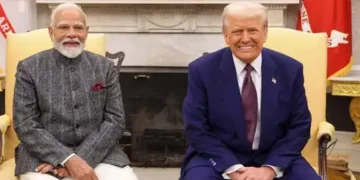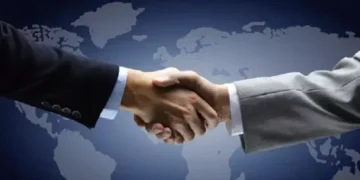 Each week, as host of The Caring Economy podcast, I connect with purpose-driven leaders navigating our interconnected world. The global stage this week is overshadowed by U.S. President Trump’s executive order: a sweeping 25% tariff on Indian exports—one of the boldest trade actions in recent memory. Numbers, decrees, and news flashes flood airwaves, but beneath these transactional tremors is a question far weightier: What do these tensions reveal about the fabric of U.S.-India relations—and the world they are helping to shape?
Each week, as host of The Caring Economy podcast, I connect with purpose-driven leaders navigating our interconnected world. The global stage this week is overshadowed by U.S. President Trump’s executive order: a sweeping 25% tariff on Indian exports—one of the boldest trade actions in recent memory. Numbers, decrees, and news flashes flood airwaves, but beneath these transactional tremors is a question far weightier: What do these tensions reveal about the fabric of U.S.-India relations—and the world they are helping to shape?
More Than Tariffs—A Tale of Two Democracies
India and America are both wrestling with economic anxiety, political polarization, and questions of identity. In India, growth stutters, job shortages deepen, and debates over social cohesion intensify. In America, economic insecurity, immigration, and inflation dominate the headlines. The tariff standoff is not just a clash over dollars and cents; it’s a test: Can the world’s largest democracies preserve essential partnership amid competing priorities and domestic pressures?
Trump’s Tariff Gambit: The Immediate Storm
President Trump frames his 25% tariff as a correction to India’s “excessively high” duties on U.S. products, especially in agriculture and dairy. American manufacturers and farmers have long complained about limited access to India’s vast market. On the other hand, Indian officials point out that opening these sectors threatens the livelihoods of millions. The executive order, now in effect, covers more than $40 billion in Indian goods, sending shock waves through India’s export ecosystem—though many negotiators downplay its measurable impact, focusing instead on the strategic trust deficit it risks creating.
This new tariff complicates relations with the world’s most populous democratic nation and disproportionately affects India compared to other key trading partners. And it’s with a critical strategic ally for the U.S.
Far from being mere adversaries in a trade war, India and the United States share deep currents of democratic values, vision, and collaborative potential. Past bruising disputes have been weathered before—and after every storm, new bridges have been built in technology, education, clean energy, and defense. Consider the impact of Indian talent in Silicon Valley, or joint U.S.-India clean tech ventures reshaping lives worldwide. At their best, these successes are rooted in trust—not tit-for-tat retaliation.
Why Tariffs Alone Won’t Solve Our Real Problems
Both countries must defend vital interests, but protectionism in 2025 offers only the illusion of security. The world’s supply chains are too integrated to be unwoven without consequences. The U.S. leans on Indian innovation and affordable medicines, while Indian industry thrives with American technology and investment. Short-term applause for tough tariffs risks long-term damage to jobs, innovation, and resilience.
Instead, the real power lies in partnering to solve shared problems—energy, education, digital transformation—where both nations’ strengths multiply together.
Trade talks are fraught because they touch on more than economics. In India, smallholder agriculture and dairy represent sacred, existential red lines—rooted in social, spiritual, and economic life. For America, powerful farming lobbies demand redress and reciprocity. These are not simple policy choices, but issues entangled with national identity and pride. Symbolic clashes can amplify nationalism and make compromise all the harder.
The Diaspora: More Than Two Monoliths
It’s tempting—especially in times of tension—to cast the U.S. and India, or their peoples, as two monolithic blocs negotiating across a cultural chasm. Nothing could be further from the truth. Both societies, and especially their diasporas, are models of complexity and integration.
The Indian diaspora in the United States is one of the largest, wealthiest, and most heterogeneous in the world. From tech CEOs to factory workers, Democrats to Republicans, first-generation immigrants to third-generation citizens, the community defies easy definition. Recent years have also seen waves of undocumented migration, evolving linguistic and religious identities, and new political divides—reminding us that neither “America” nor “India,” nor their diasporas, speak in one voice.
To reduce the relationship to a binary—East and West, old and new, protectionist and free-trader—is to miss the living reality of successful integration. The intellectual, scientific, and artistic exchanges across these two democracies enrich not only their own lands, but the world. Indeed, much of what is most hopeful about the U.S.-India partnership springs from this fertile, pluralistic diaspora.
Lessons from History—And a Path Forward
History counsels patience and vision. The 2008 U.S.-India civil nuclear deal broke through decades of suspicion. That happened only when forward-looking leaders shifted their gaze from old grievances to new possibilities. Today’s test is equally urgent if not more so.
If the goal is more than fleeting transactional wins, what does success look like?
-Leverage Shared Strengths: Expand joint ventures in tech, green energy, and advanced manufacturing. Tackle climate change and health challenges as true collaborators.
– Invest in Talent Bridges: Multiply educational exchanges, research partnerships, and opportunities for young inventors, scientists, and leaders.
– Cultivate Political Imagination: Support leaders willing to look beyond the next poll. Encourage risk-taking in diplomacy as well as commerce.
– Keep Dialogue Open: Resilient relationships survive only with institutionalized and informal channels for ongoing discussion—even, perhaps especially, in times of disagreement.
– Nurture People-to-People Ties: Empower entrepreneurs, artists, students, and scientists—let the diaspora serve as a bridge in stormy weather. Support policies that enable both Indian-Americans and Americans in India to travel, study, and work across borders.
The Real Test: Beyond the Tariff Headlines
Purpose-driven leaders on The Caring Economy podcast agree: people in both nations want dignity, growth, and opportunity. Tariffs might dominate the news cycle, but lasting progress will only come from vision, empathy, and trust.
Neither the United States nor India should allow temporary setbacks, or misleading binaries, to define a century-old friendship. In a world fragmented by crisis, the greatest hope lies in living out the promise of inclusive, dynamic, pluralistic partnership—at home, across the diaspora, and on the world stage.
Let’s ensure that history remembers this moment not as the start of a new trade war, but as the turning point when two democracies, guided by wisdom, found a better way forward.
See you next week, on the air and in print.
































